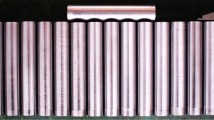Abstract
The objective of this article is to manufacture low-cost, high-quality products with maximum productivity in short time. In this work, four stages are considered: statistical investigation of the experimental results based on ANOVA, modelling based on regression analysis and mono- and multi-objective optimizations. In the first stage, turning experiments were carried out using an orthogonal array (L16) of Taguchi. Effects of cutting parameters on surface roughness and material removal rate were determined using ANOVA and interaction plots. In the second stage, regression analysis was utilized to formulate second-order models of all data gathered in the experimental works; these models could be used to predict responses in turning of X20Cr13 steel with a minor error. In the third stage, responses were used alone in an optimization study as an objective function. To minimize all responses, Taguchi’s signal-to-noise ratio was used. In the fourth stage, responses were optimized simultaneously using grey relational analysis.
Similar content being viewed by others
References
Kalpakjian S, Schmid SR (2001) International, Fourth ed. Prentice Hall Co. Manuf Eng Technol, New Jersey 536-681
Ilhan A, Süleyman N (2012) Multi response optimization of CNC turning parameters via Taguchi method-based response surface analysis. Measurement 45:785–794
Davim JP, Black JT, Ronald A, Kohser (2001) Chapter 21 Fundamentals of Machining. Mate Process Manuf
Wang MY, Lan TS (2008) Parametric optimization on multi-objective precision turning using grey relational analysis. Inf Technol J 7(7):1072–1076
Lin M, Chung-chen T, Chun-yao H, Ai-huei C, Peng-cheng H, Yu-cheng L (2013) Optimization of micro milling electrical discharge machining of Inconel 718 by grey-Taguchi method. Trans Nonf Metal Soci China 23:661–666
Chorng-Jyh T, Yu-Hsin L, Yung-Kuang Y, Ming-Chang J (2009) Optimization of turning operations with multiple performance characteristics using the Taguchi method and grey relational analysis. J Mate Process Technol 209:2753–2759
Yang WH, Tarng YS (1998) Design optimization of cutting parameters for turning operations based on the Taguchi method. J Mate Process Technol 84:122–129
Fung CP, Huang CH, Doong JL (2003) The study on the optimization of injection molding process parameters with gray relational analysis. J Reinf Plast Compos 22:51–66
Shen YK, Chien HW, Lin Y (2004) Optimization of the micro-injection moulding process using grey relational analysis and mudflow analysis. J Reinf Plast Compos 23:1799–1814
Lin CL (2004) Use of the Taguchi method and grey relational analysis to optimize turning operations with multiple performance characteristics. Mate Manuf Process 19(2):209–220
Ahmet H, Ulaş Ç (2008) Optimization of turning parameters for surface roughness and tool life based on the Taguchi method. Int J Adv Manuf Technol 38:896–903
Ihsan K, Mustafa K, Ibrahim C, Ulvi S (2004) Determination of optimum cutting parameters during machining f AISI 304 austenitic stainless steel. Mate Des 25:303–305
Liew WYH, Ding X (2008) Wear progression of carbide tool in low-speed end milling of stainless steel. Wear 265:155–166
El-Tamimi AM, El-Hossainy TM (2008) Investigating the machinability of AISI 420 stainless steel using factorial design. Mate Manuf Process 23(4):419–426
Bouchelaghem H, Yallese MA, Mabroukic T, Amirat A, Rigal JF (2010) Experimental investigation and performance analysis of CBN insert in hard turning of cold work tool steel (D3). Mach Scie Technol Int J 14:471–501
More AS, Jiang W, Brown WD, Malshe AP (2006) Tool wear and machining performance of CBN–TiN coated carbide inserts and PCBN compact inserts in turning AISI 4340 hardened steel. J Mate Process Technol 180:253–262
Bouacha K, Yallese MA, Mabrouki T, Rigal JF (2010) Statistical analysis of surface roughness and cutting forces using response surface methodology in hard turning of AISI 52000 bearing steel with CBN Tool. Int J Refract Met Hard Mater 28:349–361
Aouici H, Yallese MA, Chaoui K, Mabrouki T, Rigal JF (2012) Analysis of surface roughness and cutting force components in hard turning with CBN tool prediction model and cutting conditions optimization. Measurement 45:344–353
Suresh R, Basavarajappa S, Samuel GL (2012) Some studies on hard turning of AISI 4340 steel using multilayer coated carbide tool. Measurement 45:1872–1884
Eyup B, Seref A (2006) A study of Taguchi optimization method for identifying optimum surface roughness in CNC face milling of cobalt-based alloy (stellite 6). Int J Advanc Manuf Technol 29:940–947
Yallese MA, Rigal JF, Chaoui K, Boulanouar L (2005) The effects of cutting conditions on mixed ceramic and cubic boron nitride tool wear and on surface roughness during machining of X200Cr12 steel (60 HRC). J Eng Manuf 219:35–55
Fnides B, Yallese MA, Mabrouki T, Rigal JF (2009) Surface roughness model in turning hardened hot work steel using mixed ceramic tool. Mechanika 3(77):1392–1207
Emel K, Babur O (2013) Multi-objective optimization using Taguchi based grey relational analysis for micro-milling of Al 7075 material with ball nose end mill. Measurement 46:1849–1864
Davim JP (2011) Machining of hard materials. Springer
Arsecularatne JA, Zang LC, Montross C, Mathew P (2006) On machining of hardened AISI D2 steel with PCBN tools. J Mate Process Technol 171:244–252
Lima JG, Avila RF, Abrao AM, Faustino M, Davim JP (2005) Hard turning: AISI 4340 high strength low alloyed steel and AISI D2 cold work steel. J Mate Process Technol 169:388–95
Davim JP (2001) A note on the determination of optimal cutting conditions for surface finish obtained in turning using design of experiments. J Mate Process Technol 116:305–8
Chinchanikar S, Choudhury SK (2012) Effect of work material hardness and cutting parameters on performance of coated carbide tool when turning hardened steel: an optimization approach. Measurement 11:032
Deng J (1989) Introduction to grey system theory. J Grey Syst 1:1–24
Author information
Authors and Affiliations
Corresponding author
Rights and permissions
About this article
Cite this article
Bouzid, L., Boutabba, S., Yallese, M.A. et al. Simultaneous optimization of surface roughness and material removal rate for turning of X20Cr13 stainless steel. Int J Adv Manuf Technol 74, 879–891 (2014). https://doi.org/10.1007/s00170-014-6043-9
Received:
Accepted:
Published:
Issue Date:
DOI: https://doi.org/10.1007/s00170-014-6043-9




